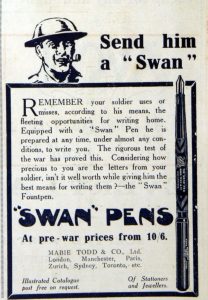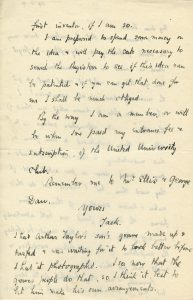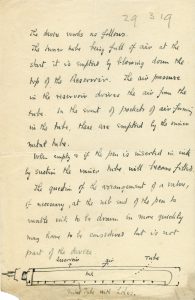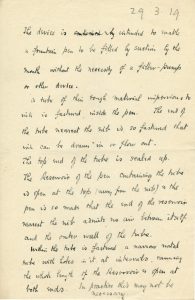Transcription
My dear Father,
It occurs to me that the enclosed device may
be worth patenting or copyrighting – I forget
which is correct in the circumstances.
Can you tell me what it would cost to get
the necessary done – in all countries? I
should also like to know what you think of
the idea. An alternative scheme is to
offer the thing unpatented to some firm on
their undertaking to take out the patents &
pay so much down or per article sold – if
they used them, but I should not do this
unless I knew something of them. Two
firms, the Swan & Jewel are both advertising
non-self-filling pens & they must be feeling
the competition of the self-filling varieties &
might take up this idea.
Personally I am very hopeful of the idea
but that is probably usual with a true and
[page]
first inventor, if I am so.
I am prepared to spend some money on
the idea & will pay the costs necessary to
search the Registers to see if this idea can
be patented & if you can get that done for
me I shall be much obliged.
By the way I am a member, or will
be when I’ve paid my entrance fee &
subscription, of the United University
Club.
Remember me to Wm. Ellis & George Daw.
Yours
Jack.
I had Arthur Taylor’s son’s grave made up &
turfed & was waiting for it to look better before I had it photographed. I see now that the graves people do that, so I think it best to let him make his own arrangements.
[page]
The device works as follows.
The Inner tube being full of air at the
start, it is emptied by blowing down the
top of the Reservoir. The air pressure
in the reservoir drives the air from the
tube. In the event of pockets of air forming
in the tube, these are emptied by the inner
metal tube.
When empty & if the pen is inserted in ink
by suction the inner tube will become filled.
The question of the arrangement of a valve,
if necessary, at the nib end of the pen to
enable ink to be drawn in more quickly
may have to be considered but is not
part of the device.
[diagram of fountain pen]
[page]
The device is contrived by intended to enable
a fountain pen to be filled by suction by the
mouth without the necessity of a filler-pump
or other device.
A tube of thin tough material impervious to
ink is fastened inside the pen. The end of
the tube nearest the nib is so fastened that
ink can be drawn in or flow out.
The top end of the tube is sealed up.
The Reservoir of the pen containing the tube
is open at the top (away from the nib) & the
pen is so made that the end of the reservoir
nearest the nib admits no air between itself
and the outer wall of the tube.
Within the tube is fastened a narrow metal
tube with holes in it, at intervals, running
the whole length of the Reservoir & open at
both ends. In practise this may not be
necessary.
Commentary
There is a lot to annotate in this letter, but what I would like to concentrate on is the self-filling fountain pen. #TeamPeirs has often talked about it as a great example of post-war boredom. Clearly Jack has thought about this fountain pen – a lot. He has had time to think though the mechanism, investment in and marketing of the product, and, I think, it is safe to assume that this is not his first sketch. During the previous 3 ½ years, Jack had been writing extensively. The 200+ letters on this site are just a portion of what he wrote. There were handwritten reports, forms, notes, orders, and other letters that have not survived as part of this manuscript collection.

August 1918 advertisement for Swan pens. Advertisements for pens using the images of soldiers was common.
He wrote in pencil and in pen, the latter a dip or fountain pen. By 1919, self-filling fountain pens came in several varieties, but many pens needed to be manually refilled using an eyedropper dipped in ink and most leaked. Considering the conditions that Jack was writing under throughout the war, it is no surprise that he was interested in something better. The first patents for self-filling pens were granted in 1901. U.S. Patent US678547A was granted for the Crocker Blow Filler – a similar idea to what Jack describes in his letter. Other types of pens that could “self-fill” used levers, wheels, and buttons. Whether or not Jack ever used any of these models is unclear, but knowing his fascination with mechanical innovations, I would not be surprised if he had.
Jack does not write about the pen again in future letters in the collection, nor is there any evidence that he pursued a patent, but this is not the only example of Jack thinking inventively. In a letter to his sister, Cecily, written on October 20, 1918 he recommended that her husband design a machine for filling in trenches. When he had time, Jack often thought of his car or the planes overhead – even on the day that armistice was declared, his thoughts were on teaching his men about interesting topics like steam and petrol engines. The First World War is known as a modern war, a war of technological innovation and tactical adaptation. In his own small way, Jack exemplifies this era’s sense of wonder with new technology.
It is entirely understandable that Jack, surrounded by the machinery of modern warfare, would put his mind towards the improvement of the one piece of technology that he used often – the pen.
Sources
Edison Pen Co. “A Blow Filler? A Blow Filler!” in New Pens. Accessed March 15,
2019. http://edisonpen.com/index.cfm/2010/07/06/a-blow-filler-a-blow-filler
The Fountain Pen Forum. Various conversation strings & search terms. Accessed March 15, 2019. http://www.fountainpennetwork.com/forum/
Graces Guide to British Industrial History. “Jewel Pen Co.” and “Mabie, Todd and Co.” Accessed March 15, 2019. https://www.gracesguide.co.uk/Main_Page




